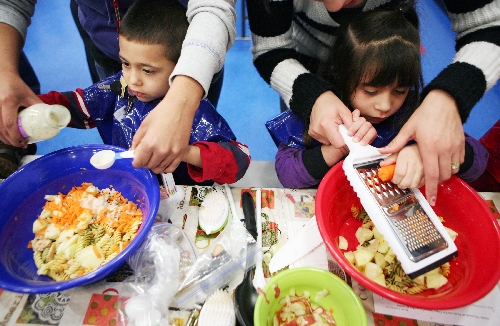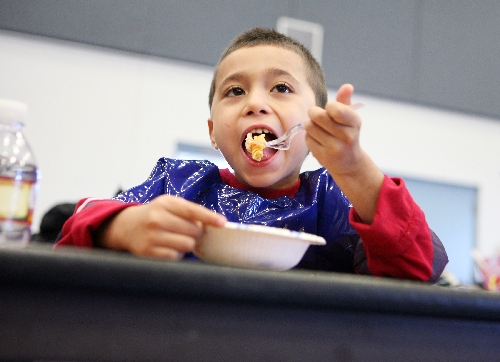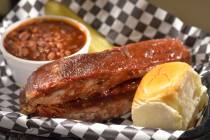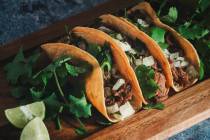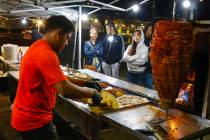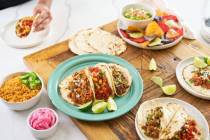Brain food: Kids learn their way around the kitchen
Want to improve your child's academic skills? Maybe you should cook with him or her.
Time in the kitchen, according to the U.S. Department of Agriculture, can foster early learning in math and science, as kids measure and count and see the changes in food as it cooks or bakes. Cooking also is an obvious opportunity for kids to improve reading and language skills.
And as a plus, it's a chance for them to see vegetables that haven't come out of a deep fryer.
But maybe you're not too comfortable in the kitchen yourself. Whether or not that's the case, Clark County Cooperative Extension, which is part of the University of Nevada Cooperative Extension, stands by ready to help. Its "Little Books and Little Cooks" program, designed for kids ages 3 to 5, is a seven-week workshop for parents and kids that teaches both about healthy eating. Learning comes through the reading of children's books, plus cooking and eating together.
It's free, and it's scheduled in various locations in the valley. But more on that later.
YaeBin Kim, extension early care and education specialist, said part of the focus is on parenting skills.
"It really helps them improve their parent-child interaction," she said of the older set. "Usually, parents don't have patience when their children make a mess." In "Little Books and Little Cooks," she said, "they have patience because they're cooking together."
Beyond learning such things as math and science skills, Kim said, the kids get a chance to build a sense of independence and confidence.
And since the target group is the prime age for picky eaters, the program's emphasis on trying new and different foods is encouragement to expand their horizons.
"This will get them to try some new foods that they haven't tried before," Kim said. "Studies have shown that when they cook on their own, they're more willing to try them. And they learn about nutrition, which also will encourage them to try new foods."
Research, she said, also has shown that kids who learn to make healthy choices early tend to retain those habits through their lives.
Kim said that as they cook with their kids, parents also learn about healthy eating.
"We are not just focusing on children, not just focusing on adults," she said. "We are focusing on both."
"Little Books and Little Cooks" isn't the only kid-focused food program in the valley. Sue Lednicky, a nutrition educator with University of Nevada Cooperative Extension and nutrition education coordinator for the Chefs for Kids program, said Chefs for Kids has been working with local schools for 23 years.
Chefs for Kids, she said, works with second-graders in 12 schools and less intensively with first-graders in about 20 schools, serving 3,500 children a year. There's a core group, she said, of about 30 chef volunteers, and others who help out occasionally.
Programs for both first- and second-graders focus on healthy eating and physical activity.
"We teach kids about how to choose healthy foods from the foods that they have available to them - which are the better choices," Lednicky said. "We teach them about choosing foods from all the food groups. We talk a lot about healthy snacking - what a snack is, first of all, because they're pretty little and they don't quite get that idea."
Fruits and vegetables are a big part of the focus, she said, and so are food-safety issues like hand-washing.
"One of our things is we want kids to enjoy nutrition; we want it to be fun," Lednicky said. "So when they're thinking of healthy eating, they're not thinking of it as a chore, they're thinking of it as something that's fun."
Even encouraging kids to think about their choices can be helpful, she said.
"If the kids can pick it up when they're little, they're more likely to retain those skills, or at least to think about it," she said. "A lot of people just eat without thinking; it's kind of a mindless act. Or you just allow your thoughts of what's good to be clouded by what advertising tells you."
Of course, you don't have to participate in a workshop to start spending time with your kids in the kitchen. The USDA points out that cooking together at home promotes bonding, increases communication and creates memories.
It's important, the agency says, to match kitchen skills to your child's abilities. Even the youngest children can stir or pour batters, shake spices and tear bread. Later they can knead dough, spread and mix. Cutting and working with heat can be done by older kids with adult supervision.
But be aware that such educational forays can have unintended consequences. Lednicky said she sometimes gets feedback from teachers whose kids are involved in the Chefs for Kids program.
"They like the fact that the kids come home and tell them, 'That has too much fat in it, Mom,'" she said. "Or, 'Why don't we try this food today, Mom?' when they've gone grocery shopping."
Here are some recipes that should be manageable with even the most pint-sized of cooks.
RICE BALLS
(Joomuk bab in Korean, onigiri in Japanese)
2 cups cooked and cooled mixed brown and white rice (use short-grain, not jasmine, basmati or Uncle Ben's)
1/8 teaspoon salt
1 teaspoon sesame oil
1 tablespoon sesame seeds
1 sheet nori (dried seaweed) cut in ½-inch strips, or use flaked or crumbled nori
Measure rice and put in a bowl. Sprinkle with salt. Sprinkle with sesame oil and mix well.
Take about 2 heaping tablespoons of rice into your hands and mold the rice into whatever shape you want. Add sesame seeds or nori.
Serves 2.
- Recipe from "Little Books, Little Cooks"
CUCUMBER YOGURT DIP
1 large cucumber
1 cup Greek-style yogurt
1 tablespoon minced garlic
2 tablespoons olive oil
1 tablespoon red wine vinegar
1 sprig fresh dill
Vegetables or fruits of your choice (1 cup per serving)
½ slice of pita bread
Note: Parents will need to help with many of the steps in this recipe.
Wash cucumber and cut in half. Peel cucumber and seed (using small spoon). Grate half of cucumber and squeeze between hands. Put in a bowl.
Add yogurt, olive oil and red wine vinegar. Chop dill and add dill and garlic to bowl. Mix well.
Slice remaining cucumber half and arrange it and other vegetables, fruits and pita bread on a plate. Serve with dip.
Serves 2.
- Recipe from "Little Books, Little Cooks"
APPLE PUDDING
1 cup leftover cooked rice
1 cup lowfat vanilla yogurt
1 cup applesauce
1 teaspoon cinnamon
Mix rice and applesauce together in a large bowl. Add cinnamon and yogurt. Stir well. Spoon into dishes and serve.
Makes six ½-cup servings.
BAHAMA BAGELS
1/3 cup lowfat cream cheese
1 tablespoon chopped walnuts
1 tablespoon crushed pineapple
2 bagels, sliced in half
Mix cream cheese, pineapple and nuts in small bowl. Spread on each half of the bagels. Serve.
Serves two to four.
CHEESY MEATBALLS
1 pound hamburger, preferably lean
½ teaspoon salt
Pepper to taste
1 cup grated cheese (preferably lowfat cheddar, American or Swiss)
1 egg
½ cup crushed high-iron cereal, such as Total, Kix, Corn Bran or Product 19
1 small can or jar of spaghetti sauce
Combine all ingredients except spaghetti sauce and mix lightly. Form into small balls and brown in pan or bake at 400 degrees until brown. Pour spaghetti sauce over meatballs. Cook slowly for 20 minutes until meatballs are done. Makes about 16 meatballs.
NOTE: This recipe lends itself to lots of small hands helping to roll the balls. (You may even want to double it to have it on hand for another meal.) Children do a great job crushing the cereal in a plastic bag with a rolling pin and rolling and shaping the meatballs. Perfectly shaped meatballs should not be the goal in this recipe.
HOT CHEESE FUNNIES
1 package dry yeast (see note)
1½ cups warm water (105 to 115 degrees)
3½ cups flour
1 cup grated cheese, preferably lowfat
1 egg
Sesame seeds
Dissolve yeast in water; stir in flour and cheese. Knead dough until smooth. Add more flour, a teaspoon at a time, if it's too sticky. Break off walnut-sized pieces and roll into 12-inch long ropes. Let children make their own pretzel shapes - or letters or numbers - and place on an ungreased cookie sheet. Brush with beaten egg and sprinkle with sesame seeds. Bake at 425 degrees for 15 or 20 minutes.
Note: Start with frozen yeast dough, thawed, if desired.
JUICY FINGER BLOCKS
3 envelopes unflavored gelatin
¾ cup boiling water
1 12-ounce can frozen apple, orange, grape or other juice concentrate
Dissolve gelatin in boiling water. Add juice and stir until mixed. Pour into a lightly greased 9-by-13-inch cake pan. Chill in the refrigerator about 2 hours, until firm.
Let kids use cookie cutters top make various shapes (including numbers and letters). Store in an airtight container in the refrigerator.
PEANUT BUTTER POPOVERS
1 can (10) refrigerated buttermilk biscuits
10 teaspoons peanut butter
10 teaspoons fruit preserves
Lay biscuits on cookie sheet.
Put 1 teaspoon peanut butter and 1 teaspoon fruit preserves on each biscuit.
Fold over each biscuit and pinch ends together tight to seal in filling.
Bake in preheated oven at 425 degrees for 10 to 12 minutes.
Makes 10.
- Recipe adapted from the U.S. Department of Agriculture
Contact reporter Heidi Knapp Rinella at hrinella@reviewjournal.com or 702-383-0474.
Upcoming workshops
The next scheduled workshops in the "Little Books, Little Cooks" program are as follows:
■ Alexander Library, 1755 N. Alexander Road, North Las Vegas: 2 to 3:30 p.m. Thursday, plus Jan. 31, Feb. 7, 14, 21 and 28 and March 7.
■ Acelero Sunflower Head Start, 1310 W. Owens Ave., 9:30 to 11 a.m. Friday and Feb. 1, 8, 15 and 22 and March 1 and 8.
■ For more information, contact YaeBin Kim at 257-5521.



